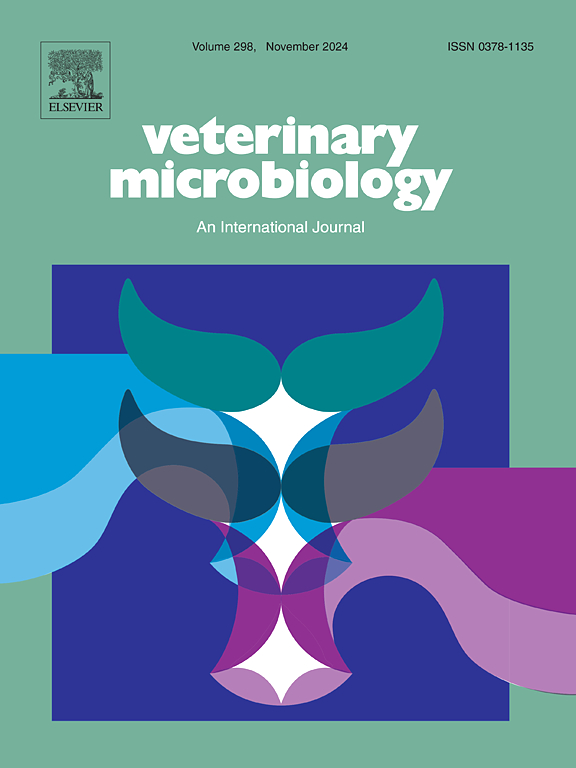Susceptibility of mastitis-causing pathogens (Escherichia coli and Staphylococcus aureus) to disinfectants used as teat dipping
IF 2.7
2区 农林科学
Q3 MICROBIOLOGY
引用次数: 0
Abstract
Mastitis is one of the most important diseases for dairy farming and Escherichia coli and Staphylococcus aureus are among the most common mastitis-causing pathogens. Aiming to prevent mastitis, pre- and post-milking disinfectant dips are used, but this constant exposure can contribute to the emergence of antimicrobial resistant strains. Thus, this study aimed to determine the in vitro susceptibility of mastitis-causing S. aureus and E. coli to disinfectants used as teat dipping. The disinfectants tested were hydrogen peroxide, sodium hypochlorite, chlorhexidine digluconate, lactic acid, quaternary ammonium, and iodine. Susceptibility was assessed through broth microdilution to obtain minimal inhibitory concentration (MIC). In general, all E. coli and S. aureus strains were inhibited with lower concentrations of chlorhexidine digluconate, hydrogen peroxide, iodine, lactic acid, and quaternary ammonium than those used in field. Regarding sodium hypochlorite, 80.77 % (42/52) of the E. coli isolates were not susceptible to the concentration recommended for use as teat dipping, while 34.5 % (138/400) of the S. aureus had the MIC equal or higher than this same concentration. In addition, an increase in the MIC according to the year of isolation of the pathogens was observed, with the latest isolates being more tolerant to all disinfectants, with exception of chlorhexidine digluconate. These results strongly suggest that continuous exposure to disinfectants can lead to the selection of less susceptible strains in dairy farming, which is a major issue for animal and public health.
引起乳腺炎的病原体(大肠杆菌和金黄色葡萄球菌)对用于浸泡的消毒剂的敏感性
乳腺炎是奶牛养殖中最重要的疾病之一,大肠杆菌和金黄色葡萄球菌是最常见的乳腺炎病原体。为了预防乳腺炎,在挤奶前和挤奶后都使用了消毒浸液,但这种持续的接触可能会导致抗微生物菌株的出现。因此,本研究旨在确定乳腺炎引起的金黄色葡萄球菌和大肠杆菌对用于浸泡的消毒剂的体外敏感性。测试的消毒剂有双氧水、次氯酸钠、二光酸氯己定、乳酸、季铵和碘。通过肉汤微量稀释获得最小抑制浓度(MIC)来评估药敏性。总体而言,较低浓度的双光酸氯己定、过氧化氢、碘、乳酸和季铵对大肠杆菌和金黄色葡萄球菌均有抑制作用。对于次氯酸钠,80.77 %(42/52)的大肠杆菌不敏感,而34.5% %(134 /400)的金黄色葡萄球菌的MIC等于或高于该浓度。此外,根据分离病原体的年份,观察到MIC有所增加,最新的分离株对除二光酸氯己定外的所有消毒剂都具有更强的耐受性。这些结果强烈表明,持续接触消毒剂可能导致奶牛养殖中选择不太敏感的菌株,这是动物和公共卫生的一个主要问题。
本文章由计算机程序翻译,如有差异,请以英文原文为准。
求助全文
约1分钟内获得全文
求助全文
来源期刊

Veterinary microbiology
农林科学-兽医学
CiteScore
5.90
自引率
6.10%
发文量
221
审稿时长
52 days
期刊介绍:
Veterinary Microbiology is concerned with microbial (bacterial, fungal, viral) diseases of domesticated vertebrate animals (livestock, companion animals, fur-bearing animals, game, poultry, fish) that supply food, other useful products or companionship. In addition, Microbial diseases of wild animals living in captivity, or as members of the feral fauna will also be considered if the infections are of interest because of their interrelation with humans (zoonoses) and/or domestic animals. Studies of antimicrobial resistance are also included, provided that the results represent a substantial advance in knowledge. Authors are strongly encouraged to read - prior to submission - the Editorials (''Scope or cope'' and ''Scope or cope II'') published previously in the journal. The Editors reserve the right to suggest submission to another journal for those papers which they feel would be more appropriate for consideration by that journal.
Original research papers of high quality and novelty on aspects of control, host response, molecular biology, pathogenesis, prevention, and treatment of microbial diseases of animals are published. Papers dealing primarily with immunology, epidemiology, molecular biology and antiviral or microbial agents will only be considered if they demonstrate a clear impact on a disease. Papers focusing solely on diagnostic techniques (such as another PCR protocol or ELISA) will not be published - focus should be on a microorganism and not on a particular technique. Papers only reporting microbial sequences, transcriptomics data, or proteomics data will not be considered unless the results represent a substantial advance in knowledge.
Drug trial papers will be considered if they have general application or significance. Papers on the identification of microorganisms will also be considered, but detailed taxonomic studies do not fall within the scope of the journal. Case reports will not be published, unless they have general application or contain novel aspects. Papers of geographically limited interest, which repeat what had been established elsewhere will not be considered. The readership of the journal is global.
 求助内容:
求助内容: 应助结果提醒方式:
应助结果提醒方式:


